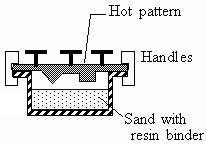|
Reference 1
The process was optimized to get a better shell by varying the temperature of the metal pattern,
holding time of sand-resin mixture and final curing time of shell and pattern.
A metal pattern having the desired shape of the casting is heated to 180 - 250℃. The pattern is sprayed
with a solution of a lubricating agent or a release agent containing silicone to prevent the shell from
sticking to the pattern. The sand is put in the dumpbox in sufficient quantity. The pattern is then turned
down with its heated face inside the dumpbox. The dumpbox is now inverted so that the sand resin mixture
falls on the heated metal pattern face. The sand mixture gets heated up and it softens the resin forming a
shell on the pattern. Initially the resin becomes sticky. Further additional heat cures it. The dump box
is again turned to its original position. The excess sand falls in the dump box leaving a shell on the pattern.
The pattern along with the shell is again kept in the heating oven. This cures the resin in the sand and
shell acquires rigidity. On the pattern ejector pins are provided to strip off the shell. After the shells
get cooled the two parts are joined properly to form a mould. Fireclay is applied along the edges of the
mould to avoid leakage of the molten metal. Shell mould was used as it had better thickness and had no breakage.
A 2 kg scrap of Aluminium Silicon alloy (LM6) was charged in a muffle furnace in a clay graphite crucible.
The dross floating on the molten alloy was removed by a thin graphite plate. The molten aluminium silicon alloy
was poured in the cavity of the shell mould.
Later on the shell mould was broken to remove the casting.
There is a virtual absence of moisture resulting in a lack of moisture related defects.
In fact, the burning resin provides a favorable anti-oxidizing atmosphere in the casting surface.
Because mold shells are thin, permeability for gas escape is excellent allowing use of finer sands.
Finer sand and excellent flowability produce dense mold surfaces and contribute to the high quality surface
finish of shell mold castings.
Reference 2
In the Shell Mold Process, mold halves are made by sprinkling resin-coated grains onto
a hot pattern. Heat causes the grains to fuse into a solid, thin shell. The halves are glued together to
complete the mold. This process provides the following benefits:
- Rigidly bonded sand provides great reproducibility and produces castings nearer to net shape with intricate
detail and high dimensional accuracy.
- Shell molded iron castings have a special metallurgical structure at the surface known as a ferritic skin.
It results from the fine graphite forming at the wall during initial solidification. This skin allows for easy
machining and smooth microfinishes.
- Castings can range from ounces up to 40 or more pounds.
- Pattern plates can be more densely packed with cavities yielding more castings per pour.
- There is a virtual absence of moisture resulting in a lack of moisture related defects. In fact,
the burning resin provides a favorable anti-oxidizing atmosphere in the casting surface.
- Because mold shells are thin, permeability for gas escape is excellent allowing use of finer sands.
Finer sand and excellent flowability produce dense mold surfaces and contribute to the high quality surface
finish of shell mold castings.
- Heat from burning slows the casting cooling rate yielding a more machinable structure.
- Resin bond strength allows smaller draft angles, deep draws, and built-in mold locators which prevent
mold shift mismatch.
- Resin bonded sand makes self-core more feasible and shell self-cored holes can be deeper and smaller
in diameter than those possible with other processes.
Tooling for shell mold is generally more expensive than for other processes, because it is more precise and
must resist heat and abrasion. Also, heat and resin binders are necessary. For these reasons, shell is most
suitable for medium to high volume parts where added value is utilized by the manufacturer.
|
 Step 1. Heated pattern is placed over a dump box containing a sand and resin mixture.
Step 1. Heated pattern is placed over a dump box containing a sand and resin mixture.